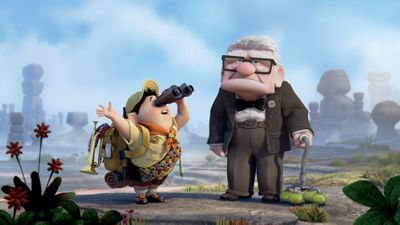‘Up’ & away
Pixar animators look to reach new heights with latest film

If Pixar films don’t look or feel like the animation of any other studio, it may be because the employees are encouraged to take risks. “We expect to fail at certain junctures,” says Pete Docter, co-director of “Up,” which opens in theaters today.
“We all started out just being movie geeks,” he says. “We watched movies and animation, deciding what works as storytelling and what doesn’t and experimenting.
“Pixar is rare in its willingness to let us try things, to take risks. And if we get hung up on something, we have these incredible animation minds like John Lasseter (‘Toy Story,’ ‘Cars’), Brad Bird (‘Ratatouille,’ ‘The Incredibles’) and Andrew Stanton (‘Finding Nemo’) that we can lean on. These guys have all made incredible films, and they’re happy to help you out.”
And another thing: Pixar animators are encouraged to make personal statements.
“John Lasseter is always asking to see more of each of us in the film,” says Docter. “He believes we all have our own unique perspectives on the world, and he wants to see them on the screen.
“We’re definitely making these movies for everybody. But we’re always looking for really strong relationships. For emotions.”
Perhaps it is that refusal to see their work as “just a cartoon” that makes “Up” such a unique experience.
In this sweet, subtle and enchanting fantasy, a white-haired widower (voiced by Ed Asner) abandons his cares by turning his house into an airship, thanks to thousands of helium balloons.
With a pint-sized stowaway, the crusty Carl navigates to South America for the adventure of a lifetime – even meeting his boyhood hero, now a mad scientist (Christopher Plummer) living in the jungle with a pack of fierce dogs.
There’s lots of action, but Docter says some of the most satisfying moments come in quiet bits of observation.
“Jim Henson once said that ‘Simple is good,’ ” he says. “Sometimes by not putting lots of busy stuff on the screen you’re actually allowing the audience to infer more on their own. In the process they become more involved. It becomes their story.
“When I watch ‘Up,’ I’m proudest of the moments where nothing much is happening. Early on we see Carl just going through his boring daily routine. The shots are static. The compositions unremarkable. And you realize that this is how he spends every day. He’s not really living. He’s just going through the motions.
“It’s always satisfying to tell a good joke. But what’s really satisfying is to get a laugh not because a character says or does something clever, but because he is that character. People laugh because they care about the characters you’ve created. They believe in them.”
At Asner’s first recording session, Docter recalls, the actor was trying out cartoony voices.
“We told him to just do his own voice,” says Docter. “It was much more rich and believable.
“I mean, animation is an artificial medium. It’s all fake. The characters don’t exist and neither do the settings. The actors aren’t recorded in the same room or sometimes even in the same city. So any key we can latch onto to create truthful moments is important.
“For actors that means getting into the character and ignoring that this is for a cartoon. Get inside that person, and then slowly flesh it out.”